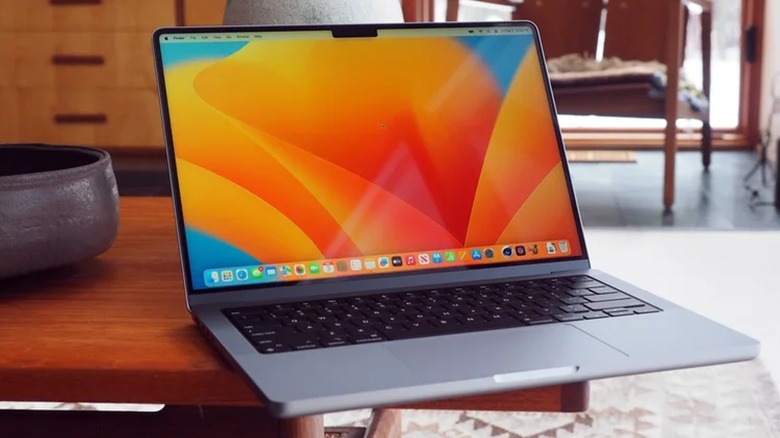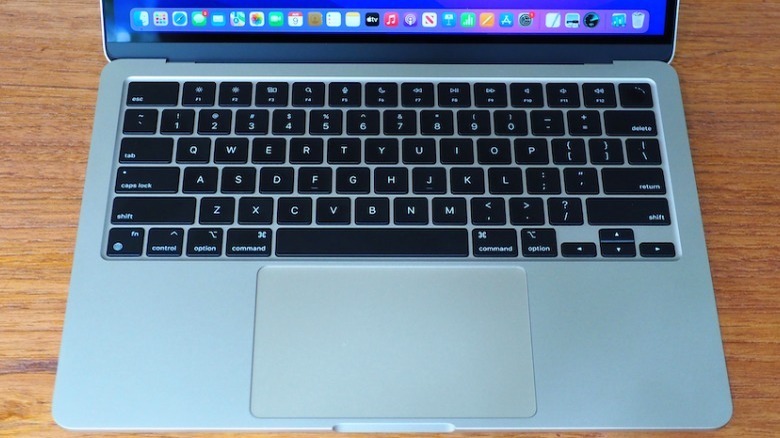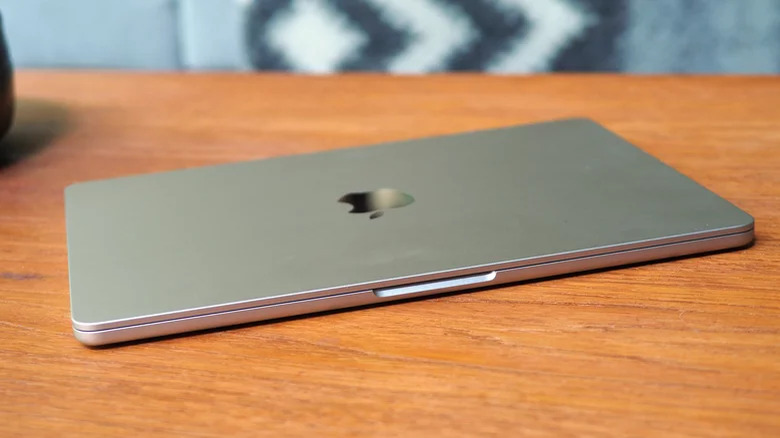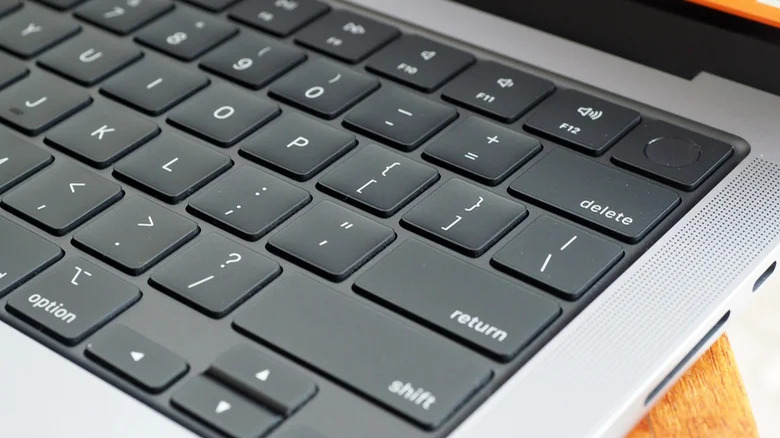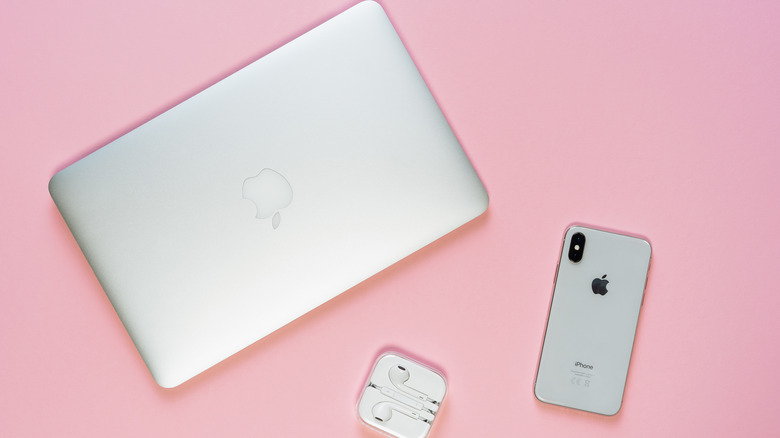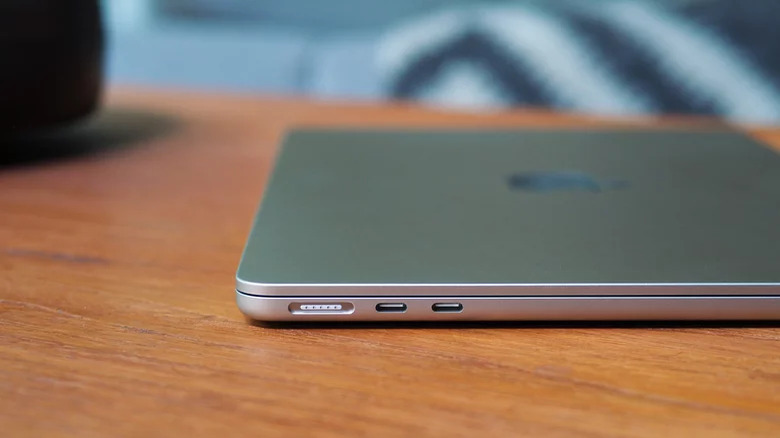10 Major Limitations Of MacBooks You Need To Know Before You Buy
The MacBook is routinely listed as one of the best laptops out there on multiple fronts. Whether you need something for remote work from home or are looking for a laptop with the best battery life, the MacBook is one of the most versatile laptops available, and all of that makes it an easy choice to pick if you're in need of a reliable laptop.
There's a variety of reasons that the MacBook makes sense for many people. It could be one of the many MacBook features that can change how you use your laptop, the high quality of the Apple Silicon MacBooks, or just the convenience of adding another piece of tech to your range of Apple products, it's not hard to justify picking one up.
However, before you jump ahead and pick up a brand new MacBook Air or MacBook Pro, it's worth taking a step back to think about some of the major limitations of owning a MacBook. For some use cases, these limitations can be major bumps in the road that you should be aware of before you buy a MacBook.
Price
While MacBooks undoubtedly offer a premium computing experience, the cost of entry is steep, potentially making them inaccessible to budget-conscious consumers and students. Despite the ever-persistent rumor that Apple is developing a low-cost MacBook, the truth is that MacBooks remain expensive. The cheapest MacBook currently sold by Apple is the M1 MacBook Air which starts at $999. If you're in the market for a more powerful machine, the M2 MacBook Pro line runs all the way up to $3,499.
What makes this a limitation is that the price is a considerable barrier to entry for many users. There are plenty of affordable laptops that are available that can handle most of your needs for far less money than the cheapest MacBook. Beyond that, to get the most out of a MacBook users often need to invest in a range of Apple accessories. From dongles to external drives and adapters, the cost of these add-ons can quickly add up. For users who need specific ports or connections, these additional expenses can be a significant obstacle to owning a MacBook.
The price is more than likely the first factor you'll want to think about before buying a MacBook, as your needs might be met by another laptop that is far less inexpensive.
Software support
One of the most significant limitations that MacBook users face is the restricted compatibility of macOS with various software applications. While Apple prides itself on its ecosystem, the walled garden approach Apple takes has its drawbacks, and software support is at the forefront. The macOS operating system is exclusive to Apple's hardware, which means that users are confined to a smaller selection of software options compared to the open ecosystem of Windows or even, in some cases, Linux.
One of the key issues is the lack of support for legacy applications. Apple tends to move forward quickly with its operating system updates, leaving older software incompatible with the latest macOS versions. This can be frustrating for users who rely on older applications for work or personal use. The need to constantly update or replace software can be expensive, making the MacBook a less cost-effective option in the long run.
Additionally, software development can be challenging on macOS due to the limited support for certain programming languages and development environments. While macOS does offer excellent tools for iOS and macOS app development, developers working with other platforms or languages may find it more convenient to choose a different operating system with broader software support.
Software support for professional applications can also be a concern. While macOS is favored by creative professionals, some industry-standard software is more commonly available on Windows. Compatibility issues can arise when working with colleagues or clients who use different platforms, and this can be a substantial drawback for professionals who rely on software that simply isn't available for macOS.
Gaming
Software support in and of itself is a huge sore spot on macOS in general, and if the software in question is for gaming, things can get even bleaker. While Apple has made strides to improve the gaming experience on macOS over the years, it still falls short when compared to the gaming-friendly nature of Windows. The primary challenge stems from the fact that macOS is not a gaming-focused platform. Most game developers prioritize Windows as their primary target due to its larger market share, leaving macOS as an afterthought.
One of the most evident drawbacks of owning a MacBook for gamers is the limited game selection. While some popular titles are available on the Mac App Store or through platforms like Steam, many high-end or mainstream games are either delayed in their macOS release or never make it to the platform at all. This means that MacBook users often miss out on some of the biggest and most exciting gaming releases while also missing out on many indie titles. Things aren't much better for virtual reality gaming. Most VR headset manufacturers primarily support Windows, leaving macOS users with minimal options.
Games developed for Windows are not always optimized for macOS, and users may encounter technical glitches, poor performance, or even complete incompatibility. Gamers often need to rely on third-party software like Wine or Parallels to run Windows games, which can be complex and time-consuming.
Repairability
MacBooks are very attractive laptops. However, Apple's pursuit of a thin, elegant design often comes at the cost of repair accessibility, making MacBook ownership a potential headache for those who value repairability and sustainability in their tech investments, an issue that has been highlighted by many "Right to Repair" advocates. While Apple has made efforts to improve in this area and even backed a Right to Repair bill in California, MacBooks remain challenging to maintain on your own.
One of the primary issues with MacBook repairability is that they are difficult to open and fix. This design philosophy prioritizes aesthetics over functionality, with components often glued or soldered together. This means that even simple repairs like battery replacement or RAM upgrades become complex and costly endeavors. Apple's penchant for sealing batteries into MacBook chassis is a prime example of this issue. Since MacBook battery health inevitably diminishes over time, owners are often compelled to have Apple service centers handle the replacement, increasing costs and limiting users who want more sustainable device ownership.
The limited repairability has further financial implications. MacBooks come at a premium price point, which can be a significant burden for users, particularly after warranties expire. Discouraging third-party maintenance can further escalate repair costs and may lead some users to invest in a new MacBook rather than deal with the repair process.
Limited hardware upgrades
To make MacBooks thinner and lighter, Apple has soldered various components directly onto the logic board, including RAM and other storage. While this may enhance the device's sleek profile, it effectively eliminates the possibility for users to upgrade these components themselves. When a MacBook's performance needs a boost, many users have little choice but to buy a new device, contributing to electronic waste.
Another significant piece of the upgrade troubles comes down to Apple's proprietary Silicon Chips, as there is simply no upgrading between generations of Apple Silicon. If, for example, the jump from M1 to M2 is vital for you, the purchase of a brand-new MacBook becomes a necessity to get that upgrade.
The lack of upgradability in MacBooks is a significant concern for environmentally conscious consumers. Electronic waste is more important than most people realize, and laptops that are not designed for user-driven upgrades contribute to the issue. Sustainable ownership, which involves extending a device's lifespan through upgrades, becomes a challenging endeavor with MacBooks.
The restricted upgradability of these devices is a critical consideration for potential owners. For those who prioritize the flexibility to tailor their laptops to their evolving needs or seek to minimize their environmental footprint, the MacBook's design philosophy may present a significant hurdle.
Limited internal storage
While some MacBook models allow for limited storage upgrades, it is a process that has become increasingly complex. The latest M1-based MacBooks use custom storage modules, rendering the replacement process more intricate than traditional SSD upgrades.
If you only use your MacBook for word processing, web browsing, and email, the internal storage might suffice, as you can likely make do with the standard 256GB or 512GB storage offered on the entry-level MacBook Air models. However, the moment you dive into more demanding tasks, the situation takes a turn for the worse. For content creators, such as photographers and videographers, limited internal storage can be a major hindrance. High-resolution photos and 4K videos can quickly gobble up storage space, necessitating external drives or cloud storage. This not only adds extra costs but can also be inconvenient when working on large media projects.
Professionals who work with large datasets, 3D modeling, or video rendering encounter limitations too. These tasks demand significant storage capacity for project files and work-related data. As MacBook Air internal storage options max out at 1TB or 2TB, professionals may find themselves juggling data across various external drives. If you do opt to pay for more internal storage in your MacBook, you add another huge monetary hurdle. The 2TB option for MacBook Airs costs $600, and if you opt for the 8TB option for internal storage for the MacBook Pro 14 and 16-inch models, it will cost you at least $2,200 extra on top of a price tag that starts at $1,999.
Customization
One of the core tenets of Apple's design philosophy is a tightly controlled ecosystem. While this approach has benefits in terms of stability and security, it also means that users have limited freedom when it comes to personalizing their MacBooks. In a world where personalization and tailoring your tech to your specific needs is increasingly valued, this can be a significant limitation.
This can also have an effect on purely cosmetic issues, as Apple's design mantra extends to the chassis as well. The elegant aluminum unibody design is beautiful but offers little room for personalization. Unlike many Windows laptops that provide customizable chassis options, MacBook users are stuck with a uniform design that may not match their personal style or preferences.
However, where the customization issues really begin to become apparant is within macOS itself. As a whole, macOS offers some amount of customization, but nowhere near as much customization as offered on Windows, and especially not near the level of customization available to Linux users. If a more personalized experience is what you seek out a laptop, be it on the hardware or the software end, then you may find the options available for MacBook rather limiting.
Ports
The quest for an ultrathin MacBook has also led Apple to trim down on available ports, which can be a source of frustration for users. While minimalism in design has its merits, the absence of sufficient ports can present challenges for those who rely on various peripherals and accessories.
The most evident port limitation on modern MacBooks is the reliance on USB-C ports. While USB-C is versatile and capable of handling multiple functions, including data transfer, charging, and video output, it also means users must carry adapters and dongles to connect their existing devices. The all-in-one convenience of a single port can quickly become a hassle when you need multiple peripherals connected simultaneously. Users who want to connect older USB-A devices, SD cards, or Ethernet cables must invest in adapters. Even something as simple as connecting a monitor using HDMI requires an HDMI to USB-C adapter. This adds extra costs and inconvenience.
The absence of legacy ports, such as USB-A or an SD card reader, can also be a limitation for MacBook users. For photographers, videographers, or professionals needing a wide range of connectivity options, this can mean additional expenses for specialized adapters and the hassle of having to use them regularly. For professionals and users who rely on their laptops for work, these limitations can affect productivity. Having to constantly switch between different adapters or manage cables can be time-consuming and frustrating. It can also disrupt the flow of work, causing unnecessary interruptions.
Support for Android devices
One of the biggest appeals of owning a Mac is cohesion. It's very likely that you might find yourself looking to buy a laptop and thinking of purchasing a MacBook just because you already own an iPhone — but what if you don't? Apple's ecosystem is optimized for iOS devices, providing a seamless experience that makes tasks such as syncing, data transfer, and device management straightforward for iPhone and iPad users. However, this level of integration doesn't extend as naturally to Android phones, which can be a drawback for those who rely on Android devices for their daily communication and productivity.
One of the primary limitations for Android users on a MacBook is the limited synchronization options. While iCloud syncs effortlessly with iOS devices, Android users must rely on third-party apps and services to keep their calendars, contacts, and notes in harmony with their MacBook, resulting in a less integrated and slightly less efficient experience. Even transferring files between an Android phone and a MacBook can be a cumbersome process. There is no native solution for seamless file sharing between Android phones and MacBooks, leaving users turning to third-party apps or using cloud-based storage solutions.
Of course, this issue goes both ways. Just as Android phones and Macs don't get along, iPhones and Windows don't get along either. While Phone Link for iOS launched for Windows 11 users earlier this year, that kind of integration doesn't hold a candle to the seamless integration between an iPhone and a Mac.
Apple Silicon and Windows
Apple's transition to its custom-designed Apple Silicon chips marked a significant leap forward in computing technology, showcasing impressive performance and energy efficiency. The only problem is Apple Silicon's inability to run Windows. Granted, an M1 Mac can run Windows 10 ARM better than a Surface Pro X, and Windows 11 can run on your MacBook, but you can't actually dual boot macOS and Windows.
Before Apple Silicon, users could dual boot both operating systems using Boot Camp. However, with Apple Silicon, Boot Camp has become a thing of the past. Windows remains the most popular operating system for PCs, used widely by individuals and businesses around the world. Some users require Windows for compatibility with specialized software, work-related applications, or familiarity with the platform. Without native Windows support on Apple Silicon, these users face significant limitations.
To bridge the gap, some users turn to virtualization software like Parallels Desktop or VMWare Fusion, which allows them to run a Windows virtual machine on their MacBooks. However, virtualization comes with a performance overhead, and not all Windows applications run smoothly in this environment, which adds an additional layer of complexity and potential frustration. These solutions are not only less convenient but can be impractical for users who require the flexibility of both macOS and Windows within the same machine.
While Apple Silicon undoubtedly offers numerous advantages, including enhanced performance and energy efficiency, its inability to run Windows natively is a notable limitation for users who rely on the Windows ecosystem. While perhaps not the most severe limitation for owning a MacBook, if you absolutely need the ability to boot into Windows, you'll be fresh out of luck within the current silicon-based MacBook lineup.
